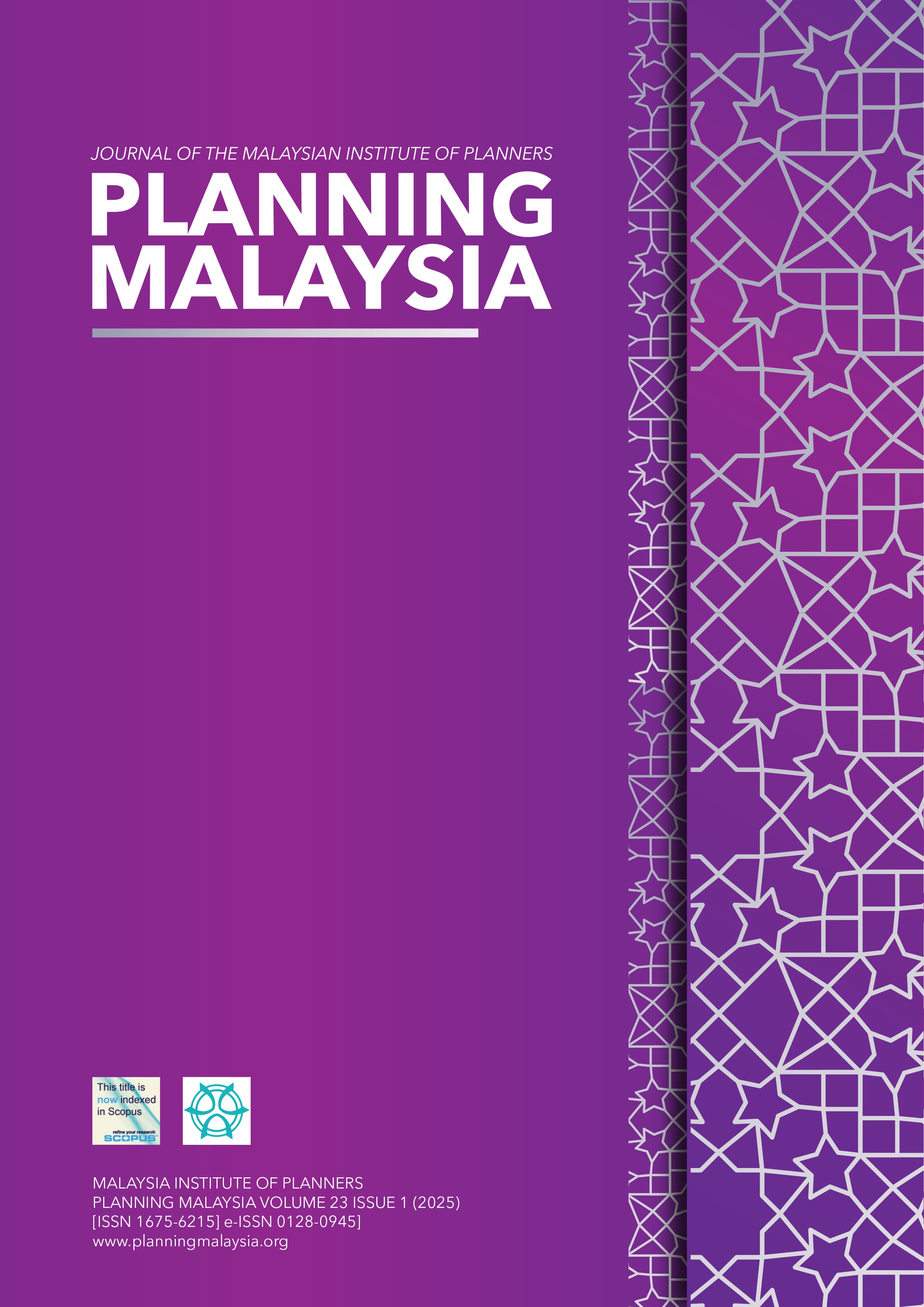AN EVALUATION OF THE ROLE OF PHYSICAL LAYOUT IN CAMPUS MASTERPLAN DESIGN TO PROMOTE SUSTAINABILITY
DOI:
https://doi.org/10.21837/pm.v23i35.1693Keywords:
Campus design, campus physical layout, urban form, morphological study, sustainabilityAbstract
Many of the current campus design development tends to be more ad-hoc and focus more on free-standing buildings in the landscape settings that do not respond to the environment of the local contexts. Those designs have been criticized for creating a high dependency on automobiles, sprawling and segregating campus outdoor spaces with roads and large parking lots that pose challenges to meet sustainability goals. This paper aims to evaluate the role of physical layout in the design of campus masterplan at Malaysian Public Universities (MPUs) to promote sustainability. Using a qualitative method of a multiple case study, a connection between physical layout and sustainability was evaluated based on document reviews, morphological studies, visual surveys, and semi-structured interview techniques. The finding reveals that the physical layout plays an important role in promoting a sustainable campus environment. It is recommended to emphasize the design of physical layout in the MPUs’ campus masterplan to ensure compactness and structured configurations, which enhance design sustainability. These are important attributes in the design approaches that should be taken by MPUs for it to be agents of sustainability.
Downloads
References
Abd-Razak, M. Z., Utaberta, N., & Handryant, A. N. (2012). A Study of Students’ Perception on Sustainability of Campus Design: A Case Study of Four Research Universities Campus in Malaysia. Research Journal of Environmental and Earth Sciences, 4(6), 646–657.
Abdullah, S. N. F., Kamarudin, M. K. A., Wahab, N. A., Purba, N., & Sanopaka, E. (2024). Enhancing Quality of Life in the Campus Community: the Effectiveness of the Green Campus Initiative. Planning Malaysia, 22(1), 241–255. https://doi.org/10.21837/pm.v22i30.1437 DOI: https://doi.org/10.21837/pm.v22i30.1437
Alexander, C., Ishikawa, S., & Silverstein, M. (1977). A Pattern Language. In ACM SIGPLAN Notices (Vol. 44). https://doi.org/10.1016/0142-694x(80)90010-1 DOI: https://doi.org/10.1016/0142-694X(80)90010-1
Caliskan, O., & Marshall, S. (2011). Urban Morphology and Design: Introduction. Built Environment, 37(4), 381–392. https://doi.org/10.2148/benv.37.4.381 DOI: https://doi.org/10.2148/benv.37.4.381
Carmona, M. (2021). Public Places Urban Spaces - The Dimensions of Urban Design (Third Edit). New York: Routledge. DOI: https://doi.org/10.4324/9781315158457
Dawodu, A., Dai, H., Zou, T., Zhou, H., Lian, W., Oladejo, J., & Osebor, F. (2022). Campus sustainability research: indicators and dimensions to consider for the design and assessment of a sustainable campus. Heliyon, 8(12), e11864. https://doi.org/10.1016/j.heliyon.2022.e11864 DOI: https://doi.org/10.1016/j.heliyon.2022.e11864
Dober, R. P. (1992). Campus Design. United States: John Wiley & Sons, Inc.
Gehl, J. (2011). Life Between Buildings: Using Public Space.
Hajrasouliha, A. (2017). Campus Score: Measuring University Campus Qualities. Landscape and Urban Planning, 158, 166–176. https://doi.org/10.1016/j.landurbplan.2016.10.007 DOI: https://doi.org/10.1016/j.landurbplan.2016.10.007
Hajrasouliha, A. H. (2015). The Morphology of the ’Well-Designed Campus’ : Campus Design for a Sustainable and Livable Learning Environment. The University of Utah.
Hebbert, M. (2016). Figure-ground: History and practice of a planning technique. Town Planning Review, 87(6), 705–728. https://doi.org/10.3828/tpr.2016.44 DOI: https://doi.org/10.3828/tpr.2016.44
Jacobs, A., & Appleyard, D. (1987). Toward an Urban Design Manifesto. Journal of the American Planning Association, 53(1), 112–120. https://doi.org/10.1080/01944368708976642 DOI: https://doi.org/10.1080/01944368708976642
Keat, L. K., Yaacob, N. M., & Hashim, N. R. (2016). Campus walkability in Malaysian public universities: A case-study of universiti malaya. Planning Malaysia, (5), 101–114. https://doi.org/10.21837/pmjournal.v14.i5.196 DOI: https://doi.org/10.21837/pm.v14i5.196
Krier, R. (1990). Urban Components. Retrieved from http://files/609/Krier - Krier, Rob, and Colin Rowe. Urban space. London A.pdf
Matloob, Faris A, & Alsoofe, H. H. (2018). Performance of Outdoor Physical Character of Kirkuk University Campus. Sustainable Resources Management Journal, 3(1), 1–29. https://doi.org/10.5281/zenodo.1154261
Matloob, Faris Ataallah. (2016). Sustainable Campus Design in Baghdad University, Iraq. Universiti Teknologi Malaysia.
McKenna, K., & Altringer, L. (2021). Alternative transportation education: implementing an innovative module. International Journal of Sustainability in Higher Education, 22(1), 157–176. https://doi.org/10.1108/IJSHE-02-2020-0080 DOI: https://doi.org/10.1108/IJSHE-02-2020-0080
Mehaffy, M. W., Kryazheva, Y., Rudd, A., & Nikos A . Salingaros. (2020). A New Pattern Language for Growing Regions: Places, Networks, Processes. Sustasis Press.
MoHE, M. of H. E. M. (2022). Pelan Tindakan Pendidikan Tinggi Malaysia 2022-2025.
Muhiddin, A. A. M., Isa, Ha. M., Sakip, S. R. M., Nor, O. M., & Sedhu, D. S. (2023). Green Campus Implementation in the Malaysian Public. Journal of the Malaysian Institute, 21(1), 274–298. DOI: https://doi.org/10.21837/pm.v21i25.1239
Nia, S. S. (2016). Campus Physical Attributes Towards Student Social Inclusion in Malaysian Universities. Universiti Teknologi Malaysia.
Samsudin, N. A., Nazri, A., Ludin, M., Alimon, N. I., Azmi, M., Hashim, H., … Khalid, A. (2018). Perancangan Kampus Kondusif Dan Mampan : UTM JB 2017-2035. (September), 20–22.
Shamsuddin, S., Sulaiman, A. B., Lamit, H., Abd. Aziz, N., Omar, R., & Md. Noor, M. (2007a). Kompendium perancangan dan reka bentuk kampus konduksif. Penerbit Universiti Teknologi Malaysia (UTM).
Shamsuddin, S., Sulaiman, A. B., Lamit, H., Abd. Aziz, N., Omar, R., & Md. Noor, M. (2007b). Kriteria Reka Bentuk Persekitaran Kampus Yang Kondusif Bagi Institusi Pengajian Tinggi Di Malaysia.
Sugiarto, A., Lee, C. W., & Huruta, A. D. (2022). A Systematic Review of the Sustainable Campus Concept. Behavioral Sciences, 12(5). https://doi.org/10.3390/bs12050130 DOI: https://doi.org/10.3390/bs12050130
Trancik, R. (1986). Finding Lost Space (Theories of Urban Design). New York: Van Nostrand Reinhold Company.
UPSI. (2003). Aspirasi Kebitaraan (M. Z. Zain & Radzuan Abd KAdir, Eds.). Universiti Pendidikan Sultan Idris.
Downloads
Published
How to Cite
Issue
Section
License

This work is licensed under a Creative Commons Attribution-NonCommercial-NoDerivatives 3.0 Unported License.
Copyright & Creative Commons Licence
eISSN: 0128-0945 © Year. The Authors. Published for Malaysia Institute of Planners. This is an open-access article under the CC BY-NC-ND license.
The authors hold the copyright without restrictions and also retain publishing rights without restrictions.


